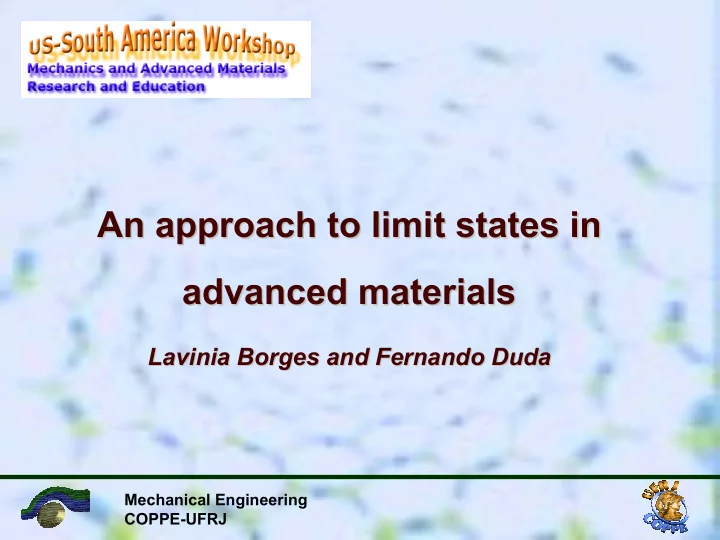

An approach to limit states in An approach to limit states in advanced materials advanced materials Lavinia Borges and Fernando and Fernando Duda Duda Lavinia Borges Mechanical Engineering COPPE-UFRJ
Solid Mechanics and Materials Group Solid Mechanics and Materials Group Professors Professors Students 16 DSc Fernando Alves Rochinha 4 MSc Fernando Pereira Duda 8 Scientific Initiation Program Lavinia Alves Borges Nestor Zouain Pereira •Structural Integrity Plasticity and Viscoplasticity Fatigue Damage Limit States •Structural Dynamic •Advanced Materials Mechanical Engineering COPPE-UFRJ
Outline � Limit States: – Limit analysis : Model and adaptive remesh – Shakedown for FGM beam Mechanical Engineering COPPE-UFRJ
Structural Plastic Collapse Analysis Limit Load Metal Forming Plastic Flow Failure Geomechanics; - Composites- Failure Criterion Bearing capacity Prediction. Mechanical Engineering COPPE-UFRJ
Limit Analysis of a continuum Mechanical Engineering COPPE-UFRJ
Limit Analysis: Discrete Model - Mixed Elements Nodes for velocities interpolation ( QUADRATIC ) Nodes for stress interpolation (linear) ⋅ = F v 1 α = ⋅ T B v min max ≤ f (T) 0 n T q ∈ ℜ ∈ ℜ v � − ∇ λ = Algorithm B v f ( T ) 0 Newton-like formula associated T α = B T - F 1 with the set of all equalities ⋅ = F v 1 included in the optimality conditions, followed by a step � � λ = ≤ λ ≥ f ( T ) 0 f ( T ) 0 0 relaxation and stress scaling in j j j j order to preserve the plastic = j 1 , … , m admissibility constraint . Mechanical Engineering COPPE-UFRJ
Estimators based on derivatives recovery The interpolation error as an indicator of the approximate solution H r (u h ) is the recovered Hessian matrix Mechanical Engineering COPPE-UFRJ
Error estimator Local error η T = absolute value of the H r - eigenvectors matrix H r eigenvalues error direction value of error Global error η= Mechanical Engineering COPPE-UFRJ
Derivative Recuperation: Weighted Average or Patch Recovering In order to approximate representing strong variations in the derivatives the adapted mesh becomes oriented by means of stretching its elements in the direction of maximum curvature of function graph S(N) ^ N ^ M Stretched Mesh and the transformed N domain defined by advancing frontal M technique Mechanical Engineering COPPE-UFRJ
First Derivative Recovery Algorithm For each node N of the mesh: 1 . Define the patch associated to N. 2. For known s ( N ), h ( N ), e 1 and e 2, built the metric tensor S( N ). 3. Transform the elements of the patch. 4. In each element compute the grad(u h ). 5. Compute recovered gradient grad r (u h ). 6. Transform grad r (u h ) to the original domain by ∇ R u h (N) = S T grad R u h (N) Taking the first derivative as a new field we reapply the algorithm to recover the Second derivative Mechanical Engineering COPPE-UFRJ
Adaptive Procedure 1.For each element compute the local error η T and then the global error η 2.Given Nel in the new mesh, compute the expected local error indicator, equally distributed on all elements, by The decreasing or increasing rate of element size is estimated by This parameter at nodal level β (N) is computed by the same approach adopted for the recovering the derivatives. 4.Compute the size of the new element h k+1 and the stretching s(N k ) node N, by where λ 1 and λ 2 are the absolute eigenvalue of Hessian matrix. 5. h k+1 _scaling Mechanical Engineering COPPE-UFRJ
Plate with imperfections (Diez, 1999) Initial mesh 1908 dof Plane Stress Plane Strain p c = 1.0350 σ Y p c = 0.9123 σ Y Final mesh:7064 Final mesh: 8194 dof Mechanical Engineering COPPE-UFRJ
Frictionless extrusion through a square die – Reduction 1/2 1 Global Error 1.5 Collapse load Global error a 1.48 a P 1.46 0.1 a 1.44 Numerical a 1.42 Slip-line 0.01 1.4 700 7000 0 2 4 6 8 10 12 14 Initial - 773 DOF DOF(Thousands) After five Steps - 12247 DOF DOF Slip-line plastic multiplier field plastic multiplier field Mechanical Engineering COPPE-UFRJ
Frictionless extrusion through a square die – Reduction 2/3 Global Error Collapse load 1 2 Global error 2a 1.98 1.96 a P 0.1 a 1.94 Numerical 1.92 Slip-line 2a 0.01 1.9 0 2 4 6 8 10 12 700 7000 DOF(Thousands) DOF Initial - 707 DOF After four Steps - 10255 DOF Slip-line plastic multiplier field plastic multiplier field Mechanical Engineering COPPE-UFRJ
Equal channel angular extrusion (ECAE ) Method for deforming materials to very high plastic strains, with no net change in the billet’s shape . By grain refinement: •control materials structure, •texture and •physico-mechanical properties. y F = 1.0 E = 2100000 ν = 0.3 20 5 x 0 5 20 Mechanical Engineering COPPE-UFRJ
Nanostructured metals by severe plastic deformation Grain subdivision Plastic Zone –Experimental Segal (1999) Dislocations accumulate in walls Winther and Huang, 2003 Plastic Zone and velocity field - Numerical Mechanical Engineering COPPE-UFRJ
Limit States: Basic direct methods for safety assessment of engineering structures subjected to variable loading. Inelastic structures submitted to variable loads may undergo one of the following types of failure modes: • alternating plasticity (plastic shakedown), • incremental collapse(ratcheting) • instantaneous collapse (plastic collapse) - Limit analysis The objective in this analysis is the computation of the load amplification factor, α , for the domain of variable loadings, that ensures elastic shakedown. Mechanical Engineering COPPE-UFRJ
Shakedown limits (Bree diagram) ∆ T for an Al 2 O 3 / FGM / Ni 3-layer beam p p ρ d = 0.6 ∆ T (1.2 mm FGM in 2 mm height of 3 layer beam ) ∆ T ∆ T p ∆ T p ∆ T p Mechanical Engineering COPPE-UFRJ
Recommend
More recommend